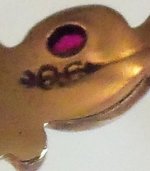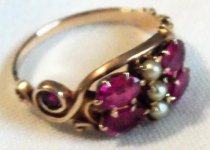You are using an out of date browser. It may not display this or other websites correctly.
You should upgrade or use an alternative browser.
You should upgrade or use an alternative browser.
Ruby and Pearl Ring
- Thread starter Anne21
- Start date
KarinK
Well-known member
Uhhh, that's pretty! I love old rings like that! You are so lucky. These would be natural seed pearls (as in not helped along by man) but small pearls like that seems to have been fairly common at the time. I have several old rings with seed pearls involved, none of them expensive. The rubies would be worth quite a bit more than the pearls.
- Karin
- Karin
Pearl Dreams
Pearl Enthusiast
Very pretty! But remember that Verneuil process -- that is, synthetic or lab-grown-- rubies were in production at this time.
Very pretty! But remember that Verneuil process -- that is, synthetic or lab-grown-- rubies were in production at this time.
Interesting! I wonder if this type of synthetic rubies can be identified through a loupe? Based on differences in crystalline structure, inclusions, etc.
Pearl Dreams
Pearl Enthusiast
Pattye, I pulled out our copy of Gem Identification Made Easy by Antoinette Matlins and A. C. Bonanno. (This is a great book, by the way.)
On the Synthetic Gemstones and Man-Made Imitation chart, it has these comments about Verneuil flame-fusion ruby identification and characteristics:
"1. Curved growth striations, curved color banding.
2. Small spherical, pear-shaped or tad-pole shaped bubbles.
3. Proliated gas bubble (a row of bubbles which, together, have a sausage-shaped outline.
4. Small black 'dots' (excessive chromium oxide that did not melt or absorb dusing the synthesis). This is often observed in old ruby synthetics.
5. Strong red fluorescence when observed under longwave ultra violet radiation.
Burmese rubies also fluoresce strong red, but weaker than the synthetic."
Elsewhere in the book (pp. 75 and 80) it says under a Chelsea filter, both natural and synthetic rubies will be strong red than without the filter but the synthetic will be a stronger red than the natural.
On p. 57 under Bubbles, it says you may need higher than 10X magnification to be sure what you are seeing are bubbles rather than a small crystal.
On p. 58 under Curved Striae, it says these are easiest to see under a microscope. Elsewhere it says 60x magnification.
I don't see anything in the book (yet) about whether the small black dots could be seen with a loupe.
I'm not a gemologist and would be very interested in exploring this further, but from the bit I've read, I don't think I would count on a loupe to tell natural from synthetic rubies. But maybe a Chelsea filter would be a relatively portable and inexpensive thing to take along as long as you have a natural (and fluorescent) ruby on you for comparison.
There may be more info on the Gemology Online forums. Link: http://www.gemologyonline.com/Forum/phpBB2/index.php
On the Synthetic Gemstones and Man-Made Imitation chart, it has these comments about Verneuil flame-fusion ruby identification and characteristics:
"1. Curved growth striations, curved color banding.
2. Small spherical, pear-shaped or tad-pole shaped bubbles.
3. Proliated gas bubble (a row of bubbles which, together, have a sausage-shaped outline.
4. Small black 'dots' (excessive chromium oxide that did not melt or absorb dusing the synthesis). This is often observed in old ruby synthetics.
5. Strong red fluorescence when observed under longwave ultra violet radiation.
Burmese rubies also fluoresce strong red, but weaker than the synthetic."
Elsewhere in the book (pp. 75 and 80) it says under a Chelsea filter, both natural and synthetic rubies will be strong red than without the filter but the synthetic will be a stronger red than the natural.
On p. 57 under Bubbles, it says you may need higher than 10X magnification to be sure what you are seeing are bubbles rather than a small crystal.
On p. 58 under Curved Striae, it says these are easiest to see under a microscope. Elsewhere it says 60x magnification.
I don't see anything in the book (yet) about whether the small black dots could be seen with a loupe.
I'm not a gemologist and would be very interested in exploring this further, but from the bit I've read, I don't think I would count on a loupe to tell natural from synthetic rubies. But maybe a Chelsea filter would be a relatively portable and inexpensive thing to take along as long as you have a natural (and fluorescent) ruby on you for comparison.
There may be more info on the Gemology Online forums. Link: http://www.gemologyonline.com/Forum/phpBB2/index.php
Pearl Dreams
Pearl Enthusiast
More reading:
http://www.gemstones-guide.com/Testing-Synthetic-Gemstones.html
There's a photo at 25x magnification of the curved striae of the flame-fusion rubies here (scroll down): http://www.bwsmigel.info/lesson9/de.synthetics.simulants.html
http://www.gemstones-guide.com/Testing-Synthetic-Gemstones.html
There's a photo at 25x magnification of the curved striae of the flame-fusion rubies here (scroll down): http://www.bwsmigel.info/lesson9/de.synthetics.simulants.html
GemGeek
Pearlista
A chelsea filter and a pen light will make any flame fusion synthetic rubies glow like beacons! Antoinette loves showing people this "trick". 
GemGeek
Pearlista
Definitely, www.gemologyonline.com is a very good reference and a great forum where you can ask newbie questions about gemstones. 
KarinK
Well-known member
Definitely, www.gemologyonline.com is a very good reference and a great forum where you can ask newbie questions about gemstones.
As long as you don't mention the chelsay filter! It is not considered in any way a tool for analyzing gems and they tend to flame people who bring it up. That being said, the forum is as informative and nerdy as PG
- Karin
Pearl Dreams
Pearl Enthusiast
I completely forgot that I had a lab-grown corundum (ruby) briolette that I could look at with a lighted 10x magnifier.
I can see the growth lines readily.
I can see the growth lines readily.
GemGeek
Pearlista
The Chelsea filter has limited applications and people do think it's over-used, but it is one of the best ways to determine that certain stones are synthetic. Antoinette's book is a great wet-your-feet start to figuring out the clues to gemstone id. It gives guidelines, not guarantees, but why not have some fun?
KarinK
Well-known member
The Chelsea filter has limited applications and people do think it's over-used, but it is one of the best ways to determine that certain stones are synthetic. Antoinette's book is a great wet-your-feet start to figuring out the clues to gemstone id. It gives guidelines, not guarantees, but why not have some fun?
Couldn't agree more! Have the book and most of the the common tools. Except I felt really embraressed when I called the gemologist of an auction house because a ruby in a ring for sale didn't give the expected response to my Chelsea filter. Turned out the Vietnamese ones (I seem to recall) don't have iron in them so they react differently from the rest. It also didn't help me spot the lab created ruby I did buy (at the price of the gold so no problem).
Gem ID is a fun world to get into but pearls are generally cheaper
- Karin


